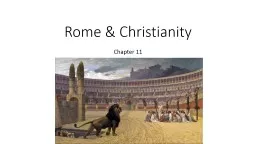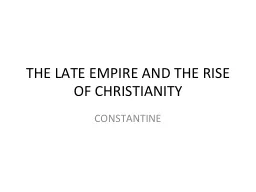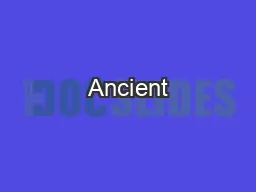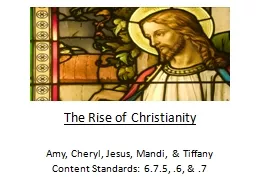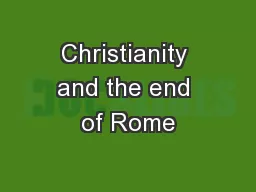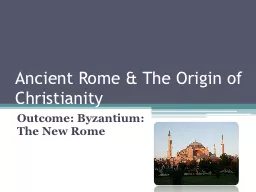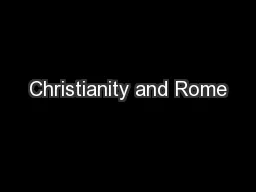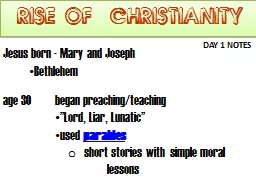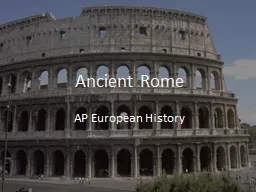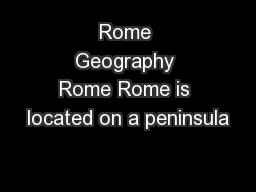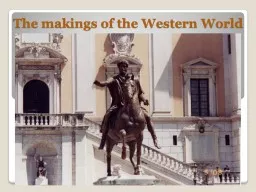PPT-Rome & Christianity Chapter 11
Author : missroach | Published Date : 2020-06-16
From Republic to Empire By the 1 st Century BC The Roman Republic was in trouble It did not survive the great changes that took place Political power broke down
Presentation Embed Code
Download Presentation
Download Presentation The PPT/PDF document "Rome & Christianity Chapter 11" is the property of its rightful owner. Permission is granted to download and print the materials on this website for personal, non-commercial use only, and to display it on your personal computer provided you do not modify the materials and that you retain all copyright notices contained in the materials. By downloading content from our website, you accept the terms of this agreement.
Rome & Christianity Chapter 11: Transcript
From Republic to Empire By the 1 st Century BC The Roman Republic was in trouble It did not survive the great changes that took place Political power broke down Riots to restore power to Tribunes. Big Idea. Get your book!!!. Anticipatory Set. Alias, alibi, camera, extra, focus, media, radius, and recipe. . These are words that were created by the Romans.. What other things can you think of that the Romans gave us?. CONSTANTINE. PANTHEON REVIEW. WHY IS THE WORK SIGNIFICANT – HOW DOES IT SPEAK FOR IT’S TIME / GENERATION?. In what way do the visual qualities of the building reflect the culture’s social, religious and /or political values of the time, or the chief concerns of this time?. Outcome: Byzantium: The New Rome. Constructive Response Questions. Citing specific examples, what factors allowed Byzantium to prosper while the west floundered?. What will we learn?. What was Byzantium?. Amy, Cheryl, Jesus, . Mandi. , & Tiffany. Content Standards: 6.7.5, .6, & .7. The First Christians. Kingdom of Israel= Division. Roman Rule. Jews under Roman control:. - 63 BC Romans took over Judah. Issues. Apologetics. Unity. Apostolic . Succession. Eucharist. Baptism. Heretics and schisms. Lapsi. (Lapsed ones). Petrine. . primacy. Epicopate. in general. Sources of Information. Didache. Church Fathers. Martyrs. Bishops. Patriarchs. Pope. Chapter 7 Section 5 Terms. Teachings and execution of Jesus Christ. Conversion of Constantine. Second temple destroyed. Christian persecution. Rome’s official religion. Judea becomes Roman province in 6 A.D., mostly Jews who held tightly to their religious beliefs and laws. Thought Roman rule would corrupt their religion. . Christian Founders. Jesus. : Jewish prophet who traveled and preached throughout Judea. Focused mostly on unconditional love and worship of God.. Outcome: Byzantium: The New Rome. Constructive Response Questions. Citing specific examples, what factors allowed Byzantium to prosper while the west floundered?. What will we learn?. What was Byzantium?. A movement, A Man, and The Entire Change of Western Civilization. Judaism in the Roman Empire. By 6 AD the area of Judaea (the lands of the old Jewish kingdom of Judah) had fallen under Roman control. . Jesus born - Mary . and . Joseph. Bethlehem. age . 30 began preaching/teaching. ”. Lord, Liar, . Lunatic”. used . parables. short . stories with . simple . moral . lessons. DAY 1 NOTES. Life and teachings of Jesus Christ becomes the . Objectives. Explain how geography influenced the development of Rome. Discuss the evolution of Roman government. Describe the growth of the Roman Empire. Compare/Contrast the effectiveness of Roman leaders. Located along the Mediterranean sea. Mediterranean climate. The . Alps and . Appinies. . m. ountain ranges protect Rome from outsiders and made it difficult to travel across the peninsula. Home of Mt. Vesuvius (volcano). Thesis. With the fall of Rome many Europeans found themselves with a common, sociocultural and patriarchal void in their lives. Eventually, with the long and often violent Christianization of Europe, that void was filled. However, this constant squabbling led to chaos on a large scale, causing medieval life to become incredibly dangerous for the common man. In order to cope with these dangers the lower classes gave up freedom to receive protection from the higher classes causing a rigid, hierarchical system to arise to keep balance and order. . AIM – How did Christianity originate? What made it different than Judaism? How did it become so popular?. Do Now: Look at the map and write down three conclusions about Christianity. . https://www.youtube.com/watch?v=BJ0dZhHccfU.
Download Document
Here is the link to download the presentation.
"Rome & Christianity Chapter 11"The content belongs to its owner. You may download and print it for personal use, without modification, and keep all copyright notices. By downloading, you agree to these terms.
Related Documents

